Comparison of Peristaltic Pumps Used for Sample Introduction in Inductively Coupled Plasma–Atomic Emission Spectroscopy (ICP-AES)
Inductively coupled plasma–atomic emission spectroscopy (ICP-AES) relies on the use of a peristaltic pump for sample introduction. Here, two conventional peristaltic pumps are compared with a new pump based on the “easy click” principle for the analytical figures of merit.
In this investigation, two conventional peristaltic pumps are compared with a new pump based on the “easy click” principle using a simultaneous ICP-AES instrument with standard operating conditions. It is found that the figures of merit achieved are quite comparable for all three pumps. Relative standard deviations (RSDs) range between 0.2% and 1.8%, and limits of detection as low as 0.1 µg/L have been achieved , demonstrating that the easy click principle of the new pump does not compromise the analytical figures of merit.
Atomic spectroscopy has a long history that starts with Sir Isaac Newton (1643–1727) when he was theorizing about color in 1704 (1). He introduced the idea of the “spectrum,” which he believed was made up of different components of light.
Many years later, in 1814, German physicist Joseph von Fraunhofer paved the way for modern absorption spectroscopy when he interpreted the black lines in the sun’s spectrum (2). In the later nineteenth century, German chemist Robert Bunsen, together with physicist Gustav Kirchhoff, examined the colors of the spectrum of a flame, and laid the foundation for today’s atomic spectroscopy (3).
In 1955, Sir Alan Walsh published his work on atomic absorption spectroscopy (AAS) (4). Since then, this analytical method has been in daily use in many thousands of analysis systems to determine the concentration of various elements, primarily in liquids. Considerable efforts were made to develop AAS from a single-element method into a multielement method (5), but other techniques, based on plasmas instead of a flame, namely inductively coupled plasma-atomic emission spectroscopy (ICP-AES) (6) and inductively coupled plasma–mass spectroscopy (ICP-MS) (7), were used to utilize element emissions or ionization of the analytes for today’s multi-element analysis.
All of these methods mentioned are quite similar in their construction. Each method ismade up of a system for introducing the sample, comprising of a pump and an atomizer (such as an aerosol generator) to transfer the sample into the hot zone (flame or plasma), a spectrometer (spectrograph, monochromator, or mass spectrometer), a detector, and a control computer complete with software for operating the machine and analyzing the results. Although analysis systems from different vendors differ radically, some components are nevertheless very similar. This is true of the pump systems used to feed the liquid sample into the nebulizer or the atomizer. As a rule, users take little notice of these components, and regularly fail to maintain and monitor them properly, even though they can. Despite the small size of the nebulizer and atomizer, these small components have a significant impact on the results of the analysis.
Peristaltic pumps are based on the principle of peristalsis, which often occurs in biological processes or organs such as the esophagus, where it transports liquids. In instrumental analysis, peristaltic pumps can be used to transport liquid samples. The basic principle by which a sample is transported is based on the alternate compression and relaxation of elastic pump tubing. The pump tubing is passed around a roller head, and pressed against the roller head with a curved pressure plate. The tubing is pressed so tightly against the roller head that it is completely sealed. When the tubing returns to its original shape behind the roller as the pump head rotates, a vacuum is created, drawing the liquid sample into the tube. Further rollers on the pump head seal the pump tubing again to form a closed segment of liquid. The rotation of the pump head drives the fluid forward in the tubing, thus causing it to flow.
The use of peristaltic pumps offers the advantage that there is no direct contact with the liquid sample at any time. Furthermore, as already described, peristaltic pumps allow constant delivery rates. As a result, these pumps help alleviate viscosity transport variations of different samples. Peristaltic pumps are available in a wide variety of designs, with significant differences in the size of the pump head and the number of rollers. The rotation speed of the pump head is usually infinitely variable, so that, depending on the inner diameter of the pump’s tubing and the rotation speed of the pump head, samples can be delivered at precise rates from a few microliters up to several milliliters per minute.
One problem that arises when using single-channel peristaltic pumps is the pulsation of the sample liquid, which can affect the aerosol generation process in the nebulizer used,(8,9)and thus will have an impact on the stability of the signal intensity measured. When a roller contacts the pump tubing, the sample liquid is displaced on both sides. The excess pressure in the tubing accelerates the sample liquid briefly, resulting in pulsating delivery to the downstream atomizer. Fluctuating delivery rates can thus potentially have a negative impact on the precision as well ason the detection threshold of the method used. When the tubing relaxes again, the volume available to the sample liquid in the tubing increases, intensifying pulsations.
A pulsation-damped pump can be used to reduce pulsation. Pulsation-damped pumps consist of at least two half-channels, with the rollers of each half-channel arranged in such a way that they are phase-shifted. This arrangement means that each peak of one half-channel is canceled out by a valley of the other half-channel. Peaks arise from acceleration of the sample liquid when the pump tubing is compressed, whereas troughs result when the pump tubing relaxes. Ideally, the pulsations of the individual half-channels cancel each other out when they are merged, so that a constant sample flow is delivered to the atomizer.
In a previous investigation, the noise spectra of different peristaltic pumps were measured, and it was shown that the noise frequency and amplitude strongly depend on the rotation speed, the number of rolls in the pumping head, and the pressure by which the elastic tubing is pressed against the roller head (10).For many commercial peristaltic pumps, this tubing pressure, which is used to press the pressure plate against the elastic tubing, will usually be increased while the tubings are altered or optimized to reduce pulsations. The rolls, meanwhile, can be adjusted manually. A new alternative is pumps with preselected settings, which do not need adjustment at all, and the required pressure is achieved by use of a spring,allowing faster changing of tubing and no need for optimization or control of the pressure (11).
This investigation compares three different peristaltic pumps to see how the analytical figures of merit, such as detection limit (DL), background equivalent concentration (BEC), and the relative standard deviation (RSD) of wavelength intensity measurements, depend on peristaltic pump conditions. In this study, multielement standards are applied for measuring 10 selected elements simultaneously using standard operating conditions of an ICP-AES instrument. The elements are selected to cover a broad range of excitation energies, and should cover the whole mass range from lowest to highest.
Materials and Methods
Standards
Stock solutions of two multielement standards with 24 elements each (Merck VIII and XVI Certipur multielement standards, Merck Millipore) with a concentration of 100 mg/L plus 2 mL concentrated HNO3 (stock solution) were diluted in bi-distilled water acidified with HNO3. The stock solutions were diluted in bi-distilled water, and two different concentrations were diluted: concentration I:2.5 µg/L; concentration II: 25 µg/L were prepared for each element. These concentrations are selected to be 10 times or 100 times above the instrumental DL provided by the manufacturer.
Instrumentation
For all measurements, a Spectro Arcos (12) (Spectro Analytical Instruments GmbH) simultaneous measuring optical emission spectrometer with inductively coupled plasma excitation (ICP-AES) was used (13). The instrument includes a Paschen-Runge mount optical system, where all elemental lines are focused onto a curve, called a Rowland circle, on which a linear array of electronic detectors is installed covering the wavelength range from 130 to 770 nm. The instrument provides two different orientations of the plasma source, and thus can be easily operated in radial or axial observation mode. All measurements presented here were performed in axial observation mode.
The following plasma and operational conditions were selected: a plasma forward power: 1400 W, a plasma gas flow rate at 13 L/min, a Nebulizer flow rate at 0.85 L/min; a single measurement time at 28 s. A crossflow nebulizer (AHF Analysentechnik) was used for all investigations.
For wavelength selection, wavelengths provided by the instrument manufacturer’s software were selected. During the blank measurement, the background structures in the wavelength region were evaluated to account for any spectral interference.
For calibration, three intensity measurements with 10 and 4 repetitions were performed, consisting of a measurement of the blank and measurement of two standards with concentrations of 2.5 µg/L and 25 µg /L, respectively.
Peristaltic Pumps Tested
Three different peristaltic pumps were selected for this investigation: I) the peristaltic pump of the Arcos device, and II) a Perimax peristaltic pump (Spetec GmbH) that is externally operated. The pressure of the pumping head of both were optimized before measurements, as to give lowest RSDs. The third pumpwas an “Easy Click” peristaltic pump (Spetec GmbH), also externally operated. All pumps were connected to an auto-sampler (Asx-260 Cetac).
All pumps were operated using a sample up-take rate of 0.8 mL/min, controlled by a volumetric measurement. For all experiments new tubing (ID color code: orange-orange, Spetec GmbH) was used, except in the Spectro device; here the tubing was in use for more than a fortnight, and this “matured” condition served as a reference value used to see if old tubing compromised the figures of merit.
Measurement Details
For each pump the following measurement procedure was applied: First, a blank measurement was performed, and then two multielement solutions with concentrations of 2.5 µg/L and 25 µg/L were measured.
Results
Wavelength Selection and Data Evaluation
In a first test run, 10 (n = 10) repeated intensity measurements for at least 5 preselected lines per element were performed. The calibration data for all lines are compiled in Table I, and the number of wavelengths is reduced to a single one (indicated in Table I) to compare all three pumps. However, the total measurement time, and time needed for calculations exceeded more than 60 min, so that the number of repetitions was decreased for all further measurements to n = 4. As a result, the final measurement and calculation time of 25 min was achieved. Standard conditions were chosen as the integration time for each element.
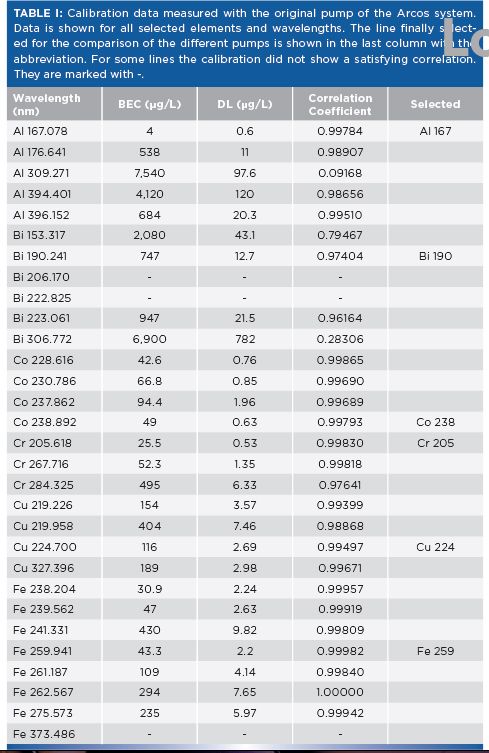
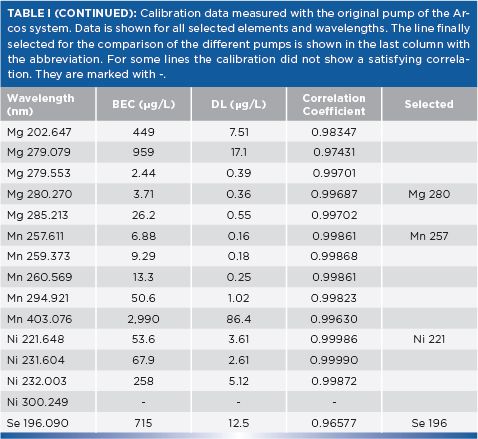
Because the peristaltic pump of the Arcos system was operated with a higher pumping speed in between intensity measurement cycles, the washout phase was doubled for the Perimax and “Easy Click” pump, which were operated manually. However, the first run of a new measurement series showed a higher concentration for these two pumps, with much higher RSD, DL, and BEC values, an indication that the sample introduction system was not in a stable equilibrium. Therefore, the first run of each series of new intensity measurement has been deleted, and thus data is given for three (n = 3) repeated measurement cycles only.
Except for Se, several lines were proposed by the software of the Arcos system for most elements, and were confirmed after a blank measurement to evaluate the background structure. For all lines selected, calibration data are available, but for the comparison of the three different pumping systems, a single wavelength with the lowest DL was selected, provided the correlation coefficient was satisfactory. Selected lines, used further on, are shown in the last column of Table I, with their abbreviations.
The stability of the plasma was controlled manually using the Ar wavelength at 430.010 nm, and the resulting RSD measured was always equal or better than 1% for all pumps and all concentrations measured.
Comparison of Analytical Figures of Merit for Three Different Peristaltic Pumps
Results for the analytical figures of merit for of all three pumps are compiled in Table II. Data provided includes the DL, BEC, and the RSD. The latter is calculated as mean value from the RSDs of both concentrations used for calibration.
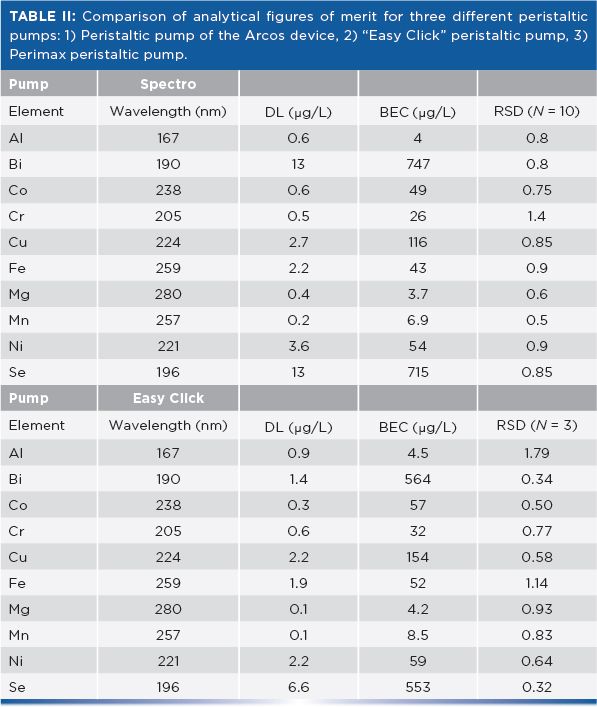
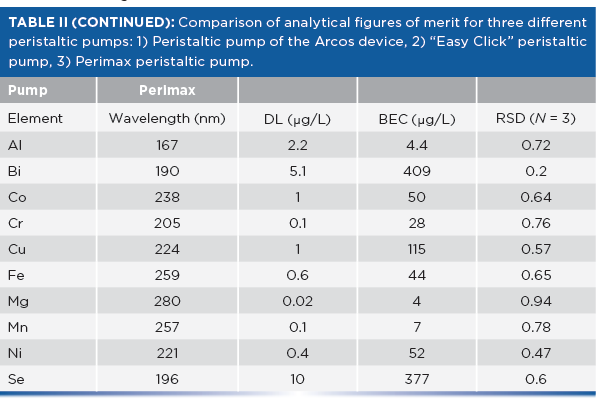
Discussion
As stated before, the original peristaltic pump of the Arcos system was operated with matured peristaltic tubing. Nevertheless, all RSD values (shown in Table II) calculated are better than 1% (except Cr: 1.4%). Blank values (not shown) are slightly higher by 10–20% compared to new tubing (likely because the tubing was extensively used for analysis of highly concentrated digestions of steel and alloys of Al, Cu, and Ni). However, DL and BEC do not significantly deviate from the values measured for the two other pumps. The Perimax pump, for which the pressure plate was manually adjusted to the lowest pulsation setting and for which new pumping tubing were used, showed the best RSD values for all elements, being better than 1%. Even the Easy Click pump with manufacturer settings showed relatively good RSD values for some elements very close to the values achieved for the Perimax pump. This result demonstrates that the manual alignment of the pressure block does not significantly improve the figures of merit, and thus is not needed if a pump with the lowest maintenance is needed. For the lines selected, all DL values are lower than 5 µg/L (except Bi and Se). For Bi, the DL could be improved by more than a factor of two mainly using new tubing, which also demonstrates that memory effects did not significantly worsen the analytical figures of merit. Finally, it should be mentioned that all three pumps tested are very comparable concerning their analytical figures of merit. In particular, low RSD values were achieved in this experiment for all pumps investigated, and can be attributed to the simultaneous detection capability of the instrument used in this investigation. Such low precision is required for traceability studies. Applying a precision measurement method for element contents, developed using ICP-AES, combined measurement uncertainties between 0.05% and 0.1% can be achieved (14).
Conclusion
In this investigation, three different peristaltic pumps were compared using an ICP-AES instrument with simultaneous detection for all elemental wavelengths of interest to demonstrate that a peristaltic pump based on an “easy click” adjustment will not compromise the analytical figures of merit. It was found that comparable analytical figures of merit can be achieved for all three pumps using standard operating conditions and very low standard deviations (below 1%) can be achieved for all pumps, if simultaneous detection of the intensity measurements is applied. For multielement analysis, such very low standard deviations and LOD values can only be achieved with ICP-AES operated with peristaltic pumps, and are essential for the development of new standard reference materials (15).
References
- I. Newton, S. Smith, and B. Walford, Opticks or, a treatise of the reflexions, refractions, inflexions and colours of light. Also two treatises of the species and magnitude of curvilinear figures. (1704).From https://archive.org/details/McGillLibrary-104448-118/page/n8.
- W. Jackson Myles, Annalen der Physik. 526, A65–A69 (2014).
- G. Kirchhoff, Annalen der Physik. 185, 148-150 (1860).
- A. Walsh, Spectrochim. Acta. 7, 108–117 (1955).
- José A. C. Broekaert, Analytical Atomic Spectrometry with Flames and Plasmas, (Wiley-VCH, New York, New York, 2006).
- V. A. Fassel, Science. 202, 183–191 (1978).
- R. S. Houk, V. A. Fassel, G. D. Flesch, H. J. Svec, A. L. Gray, and C. E. Taylor, Anal. Chem. 52, 2283–2289 (1980).
- B.L. Sharp, J. Anal. At. Spectrom.3, 939–963 (1988).
- B.L. Sharp, J. Anal. At. Spectrom.3, 613–652 (1988).
- J. Greffin, N. H. Bings, N. Jakubowski, and F. Rickert, GIT Laborfachzeitschrift 5, 32–34 (2019).
- Spetec. ECC Easy Click Compact. https://www.spetec.de/downloads/Datenblatt_ECC_EasyClick_Compact.pdf (accessed August 2020).
- Spectro. Ametek–Materials Analysis Division. https://www.spectro.com/products/icp-oes-aes-spectrometers/arcos-inductively-coupled-plasma (accessed August 2020).
- A.G.T. Gustavsson, A. Montaser, and D. Golightly, Inductively Coupled Plasmas in Analytical Atomic Spetrometry (Wiley-VCH, New York, New York, 2nd ed., 1992).
- H. Kipphardt, R. Matschat, O. Rienitz, D. Schiel, W. Gernand, D. Oeter, Accreditation and quality assurance, 11, 633–639 (2006).
- S. Recknagel, Certification Report of BAM-M319: A new AlMgSc powder; Technical Report for Bundesanstalt für Materialforschung und -prüfung (BAM): Berlin, Germany, December 2019.
Norbert Jakubowski, Sarah Borrmann, and Friedhelm Rickert are with Spetec GmbH, in Erding, Germany. Sebastian Recknagel and Janina Roik are with Federal Institute for Materials Research and Testing (BAM), in Berlin, Germany. Direct correspondence to: Sarah.Borrmann@spetec.de
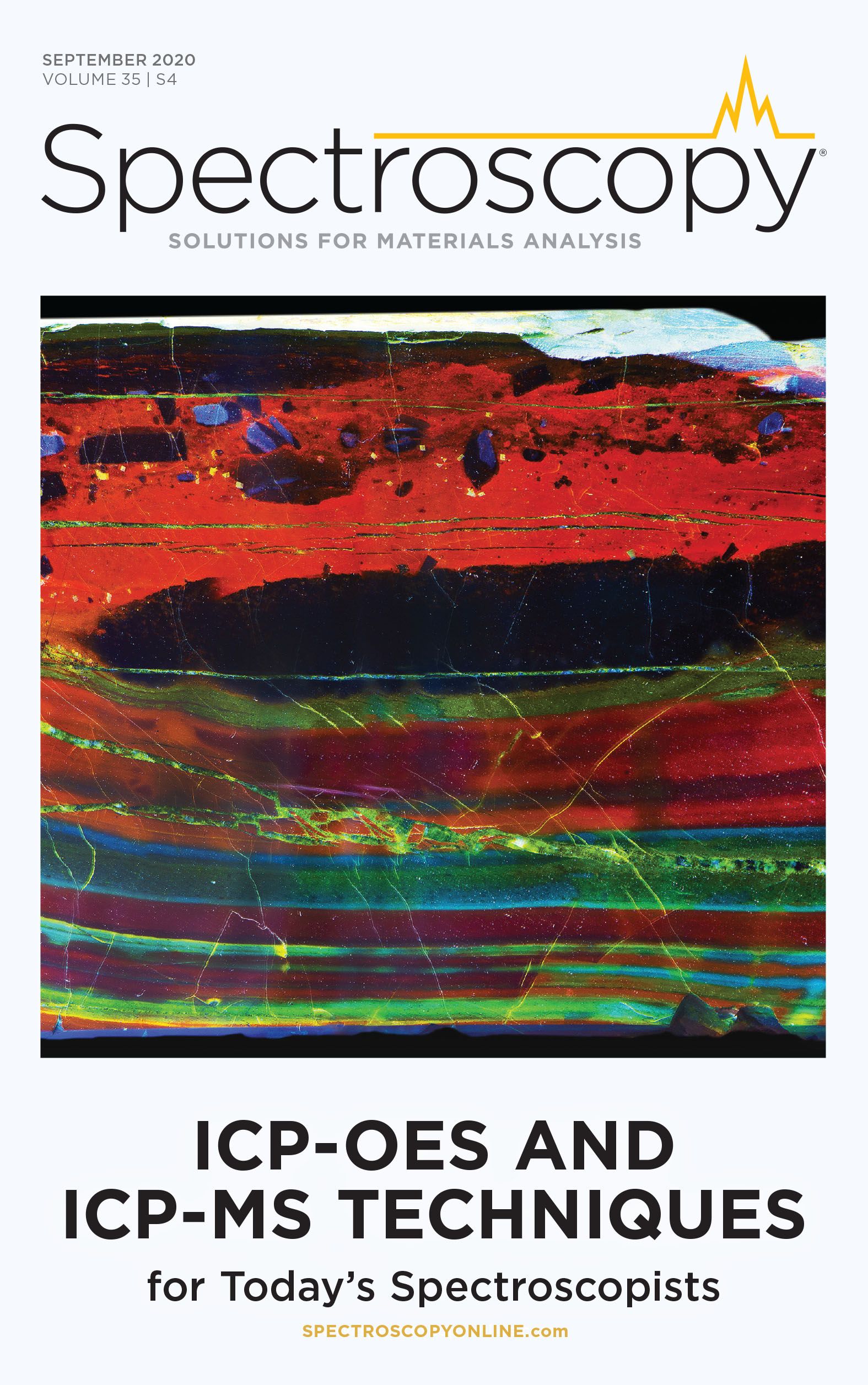
High-Speed Laser MS for Precise, Prep-Free Environmental Particle Tracking
April 21st 2025Scientists at Oak Ridge National Laboratory have demonstrated that a fast, laser-based mass spectrometry method—LA-ICP-TOF-MS—can accurately detect and identify airborne environmental particles, including toxic metal particles like ruthenium, without the need for complex sample preparation. The work offers a breakthrough in rapid, high-resolution analysis of environmental pollutants.
Trending on Spectroscopy: The Top Content of 2024
December 30th 2024In 2024, we launched multiple content series, covered major conferences, presented two awards, and continued our monthly Analytically Speaking episodes. Below, you'll find a selection of the most popular content from Spectroscopy over the past year.